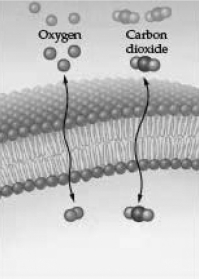A) starch
B) sugars
C) ATP
D) fatty acids
F) None of the above
Correct Answer

verified
Correct Answer
verified
Multiple Choice
The human hormone insulin is produced only by a single organ,the pancreas,yet insulin is used to move glucose from the bloodstream into cells all over the body.What aspect of hormones makes it possible for insulin to work throughout the body?
A) Hormones are able to stop cell-to-cell communication.
B) Hormones all cross cell membranes,and thus can move freely throughout the body.
C) Hormones cause rapid cell-to-cell signaling.
D) Hormones are long-range signaling molecules.
F) C) and D)
Correct Answer

verified
Correct Answer
verified
Short Answer
After entering its target cell,a hydrophobic hormone binds to its intracellular receptor and then interacts with the cell's DNA,resulting in the production of a specific ________.
Correct Answer

verified
Correct Answer
verified
Multiple Choice
What best explains the double-headed arrows associated with carbon dioxide and molecular oxygen shown in the following illustration?

A) Individual molecules are unable to cross the membrane,but they can be found in relatively large numbers on both sides.
B) The membrane is permeable to these small molecules and they enter or leave rapidly as their concentration gradients change.
C) An isotonic condition exists for each molecule,so no net movement takes place.
D) Homeostasis requires that surplus molecules entering the cell be rejected and returned to the outside.
F) A) and C)
Correct Answer

verified
Correct Answer
verified
Multiple Choice
Cell signaling
A) is always a rapid process.
B) can be fast or slow.
C) is always a slow process.
D) does not occur in plants.
F) B) and C)
Correct Answer

verified
Correct Answer
verified
Multiple Choice
Elevated cholesterol and LDL (the particles that transport cholesterol) have been strongly associated with vascular disease;what process(es) lead to the elevated levels?
A) excessive absorption of cholesterol from the GI tract
B) reduced production of cholesterol by the liver
C) increased acceptance of cholesterol by body cells
D) reduced conversion of cholesterol into sex hormone receptor molecules
F) A) and D)
Correct Answer

verified
Correct Answer
verified
Multiple Choice
Imagine two solutions separated by a selectively permeable membrane that is impermeable to glucose.On one side of the membrane,solution A contains 10 percent glucose and on the other side,solution B contains 25 percent glucose.Which of the following is true?
A) Solution A is hypertonic relative to solution B.
B) The concentration of water is greatest in solution B.
C) Water will move from solution A to solution B.
D) Glucose will diffuse from solution B to solution A.
F) B) and C)
Correct Answer

verified
Correct Answer
verified
Multiple Choice
Imagine a cell needing an essential specific amino acid (one the cell cannot synthesize) .What process could acquire the amino acid most quickly?
A) Phagocytize and digest bacteria,extract the specific amino acid from the residue,and release to the cytoplasm.
B) Place a transporter protein in the membrane that could carry the amino acid across the membrane.
C) Use receptor-mediated endocytosis.
D) Use simple diffusion because the concentration of the needed amino acid will be zero and the gradient will always be maximized.
F) A) and C)
Correct Answer

verified
Correct Answer
verified
True/False
A given signaling molecule can bind to several different kinds of cell surface receptors.
B) False
Correct Answer

verified
Correct Answer
verified
Short Answer
A concentration ________ is said to exist when a molecule is more abundant in one area than it is in another.
Correct Answer

verified
Correct Answer
verified
Multiple Choice
The concentration of glucose inside a cell is higher than the concentration outside that cell,yet glucose continues to enter the cell.This is an example of
A) passive transport.
B) diffusion.
C) active transport.
D) osmotic transport.
F) All of the above
Correct Answer

verified
Correct Answer
verified
Short Answer
Even though the concentration of water in a cell remains constant in an isotonic solution,the random movement of water molecules during ________ requires that water be constantly moving in both directions across the plasma membrane.
Correct Answer

verified
Correct Answer
verified
True/False
Tight junctions prevent the movement of the extracellular matrix between cells.
B) False
Correct Answer

verified
Correct Answer
verified
Multiple Choice
Soon after a certain molecule enters a cell,the cell begins producing a new type of protein.The molecule was probably a
A) receptor molecule.
B) hydrophilic molecule.
C) carrier protein.
D) hydrophobic hormone.
F) A) and B)
Correct Answer

verified
Correct Answer
verified
Multiple Choice
Which of the following signaling molecules would NOT be found in animals?
A) auxin
B) insulin
C) adrenaline
D) testosterone
F) A) and C)
Correct Answer

verified
Correct Answer
verified
True/False
Osmoregulation refers to balancing water concentrations in organisms and cells.
B) False
Correct Answer

verified
Correct Answer
verified
Short Answer
When the solute concentration outside a cell is equal to the solute concentration inside the cell,the cell is in a(n)________ solution.
Correct Answer

verified
Correct Answer
verified
Multiple Choice
After a sex hormone enters a target cell,it
A) binds to the nucleus.
B) becomes a signaling protein.
C) binds to an internal receptor protein.
D) becomes a gene.
F) A) and C)
Correct Answer

verified
Correct Answer
verified
Short Answer
The principle of cell ________ is that different cells in the same organism may have different functions.
Correct Answer

verified
Correct Answer
verified
True/False
Plasmodesmata are not found in animal cells.
B) False
Correct Answer

verified
Correct Answer
verified
Showing 21 - 40 of 89
Related Exams